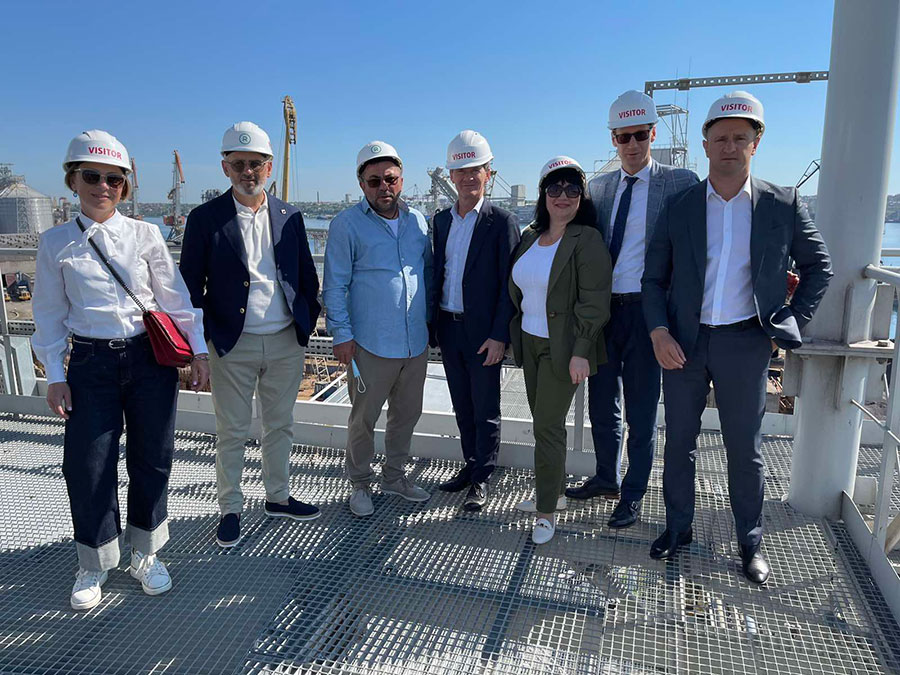Landlord June 2021
Credit Agricole says that agro is the bank's DNA. There is a reason for that. The share of the agricultural sector in the bank’s corporate portfolio exceeds 50%, and the land bank of all customers’ accounts for nearly 10% of the total land bank of Ukraine. The bank provides services to international corporations, large agricultural holdings as well as small farms. Small farmers will generate demand for the land purchase in the first stage of the land market opening, which will start on July 1, 2021.
Are banks ready to finance farmers for buying land? What products will Credit Agricole offer them? What will the programs for the agrarian sector under the new economic realities? Will farmers get easier access to finance after the land become collateral, and how will the bank's strategy change? The answers to these and many other questions are in an interview with Larysa Bondarieva, Deputy Chairman of the Management Board, Corporate and SME of Credit Agricole Bank.

About land market parameters
Currently there are different views regarding parameters of the future land market. We start from the fact that land lease agreements of approximately 6–8% of land shareowners are to be expired in 2021, and not more than a half of them will be ready to sell their land shares. However, even that volume may require financing in the amount of USD 600-700 m. Does the banking system have the liquidity sufficient to satisfy such demand now?
The banking system should be able to handle it. Indeed, there are many mathematical models of future market parameters, which show different volumes. By our estimates, during the first year after the market opening 3–5% of subdivided land will be put up for sale, and yet that offer will be singular – land shares will be put up for sale by those owners who need to get money quickly.
We communicate with our customers a lot, especially regarding the readiness of land share owners to sell the land leased by customers, and future land prices as well. Owners of land plots have high expectations about the price and think that it should be at the level of Ukraine's neighboring European countries. However, we believe that the market will need some time to reach such prices and it will start from an average USD 2000 per hectare at first. Therefore, those expecting the price of USD 5000–600 per hectare will probably refrain from selling.
How occurrence of selling offers you have mentioned will affect the lending market?
Buyers will obviously turn to banks to apply for loans. However, it will be unclear at the start: soon-to-be buyers have already accumulated some of the money. Typically, such buyers are those currently working on that land, meaning lease-holding farmers. Its owners, their family members, relatives, will purchase the land – they have been preparing for the market opening for a long time, not a year or two, and have been accumulating money to enter the market immediately. That is to say, such buyers will take up a part of initial volume of offers, and agreements under the other half will be financed directly by banks. And the banks will do so – the banking system is facing a colossal window of opportunities.

Watch the video "Agri arts" by Credit Agricole
About legal entities and private individuals
We have already heard an opinion of banking sector representatives that the lending will be slow until 2024, when the market will be opened to legal entities…
Yes, the model of market opening approved in Ukraine differs from initial expectations of the market players. However, I would rather talk about advantages and opportunities. Even if the mechanism does not work at full capacity by 2024, banks will receive potentially interesting portfolios for long-term lending against an attractive asset. We have studied the experience of countries, where the Credit Agricole Group operates, and the market opening there became a driver for development of lending and financial market at whole. They started with land financing and in the process of development received wide range of financial instruments to boost the economy. There is currently enough liquidity on the Ukrainian banking market – demand for loans is what we need.
There is talk now that legal entities will became the market players immediately, one way or another. That is mean that various dubious schemes for land purchase will arise and banks given the asset’s attractiveness will participate in such schemes. How do you feel about these allegations?
The market has just started writing its history and in my opinion, it is too early to draw conclusions. I am sure that main players on the market, including Credit Agricole in particular will work only within legislative framework. This year, we will start land financing for private individuals, which is a consolidated position on the banking market. After that, when sale of land to legal entities will be legitimately opened (in 2024) we will start to provide financing to this segment too. That will be the second wave of the market opening, which will be much stronger than the first one – there will be the time for completely different volumes of loan agreements and investment projects of other level in the industry. I have many conversations with agrarians from all regions of Ukraine and I can say that farmers from different regions, not only southern ones, explore the possibility of buying land, gradually accumulating land plots in order to be able to implement irrigation. Pay back of such projects is long-term and very few people would dare to implement them on leased land. Owned land is a different story for both the farmer and bank, which will finance high-cost projects.
Speaking of which, how logical was it in general to carry out the reform in that way? Why a private individual was put between a source of financing and a real leaseholder? Wouldn’t it be much easier to open the market for legal entities in the first place?
Legislator defined the parameters of the market’s first stage. Although this decision has caused many questions at the beginning, especially among legal entities, which had proved their efficiency in agricultural sector. Now they see the situation as it is.
Let’s look at the situation on the other hand. Perhaps these three years is a kind of a time “gap” to the benefit of the market – it will allow adopting to new realities, working out mechanisms, developing financial products, and get experience with new asset. Indeed, Credit Agricole operates in countries where land markets have long been opened, but that does not mean that everything is easy – each country has its own specifics and work model. Ukraine does not have such experience at all and we have to gain it ourselves. We will move forward gradually, in small steps and that is the right way to do it.

About products for the land market
It is easy enough for banks to work with legal entities, while issuing long-term loans to private individuals for purchase of land seems to be problematic. Have you already decided what product you will offer for the market opening?
No doubts, it will be a kind of mortgage lending, which is logical. Lending period are discussed on the market and we tend to terms closer to 10 years. The product is currently being finalized, in particular interest rate and amount of the amounts advanced. The interest rates should be affordable to borrowers since it is in our own interest that the product advances. On top of that, customers expect the government’s participation in declining interest rates on land loans in order to make them more affordable for individuals.
When will you offer your new land loan product?
Customers expect our support from the very beginning, July 1. Our intention is to make it in time. We are finalizing the product and waiting for certain regulations to be adopted. We are also studying the issue of how the whole eco system would work – will notaries and registries cope with it. As I told, it is not bad that the market will be opening gradually – we will have an opportunity to work out all processes, make adjustments and receive full-fledged market with the whole system that ensures its operational activity by 2024.

In reality, not “100 ha plots” market, but rather “a lot of 2 ha plots” market will open. How convenient would it be for the bank to work on financing purchase of plots located in the middle of the land without any approaching roads? Is such asset valuable at all from the bank’s point of view?
At the initial stage, there will definitely be certain chaotic and we would be more comfortable working with consolidated plots of maximum 100 ha as permitted by the law.
We expect that buyers with pre-formed “pool” of larger area plots will contact us for financing. On the other hand, legislator understand this problem as well – a bill, which regulates exactly the issue of land consolidation is currently under consideration.
We are deeply involved in the market pre-opening process, which is one of the major projects in the country, on agricultural market, and Credit Agricole in particular. There are many questions and concerns. I stress once again that banks do not intend to become latifundists. We are interested in supporting our customers and financing their agreements. When we work out our models, the stake is placed on how this loan is going to be repaid. In other words, the bank “needs” not only a private individual that has certain income and applies for a loan. It is important for us that the land generates cash flow meaning that such borrower works on that land or has a lease agreement for a land plot signed with a legal entity. In that case, understandable economics appears.
There are more questions than answers with the land market so far. However, I think it is a normal situation because we have never lived under conditions of free land market. We will not get answers until we start implementing norms of the land law.

About changes on the lending market
How banking products for agro sector will change once such a clear and liquid collateral like land appears? Can we expect loan rates to reduce?
There will certainly be changes, but not immediate ones. Today, the Ukrainian agro sector, which attracts loans and uses banking products to begin with, is mainly legal entities. Perhaps, we will see the growth of family farm businesses, but major changes will come after 2024. Investments in irrigation systems, which the Ukrainian agriculture urgently needs now, and investments in technological base in a broad manner will increase. Big breakthrough will be that the financing market will be opened to small agricultural producers. After all, micro business in Ukraine is underfunded – I mean farmers who cultivate 50–200 ha. We cannot say that this category of farms has no access to financing at all, but it is surely not in the banking system’s focus. It is quite understandable – medium and large companies have more resources, standardized reporting, in-house specialists, proven distribution channels, etc., and that is what small companies are usually lacking.
However, the fact that there are many such small players on the market should be taken into account. Therefore, the whole segment remains underfunded and not covered by majority of banks. Owned land as a collateral will allow negating the above disadvantages and make small producers attractive to financial institutions. Now we work with farms of at least 200 ha, but examine the potential of the market of borrowers with 50–200 ha and realize capabilities of this segment.
If we consider the statistics of agro companies’ coverage by banking institutions, it becomes clear that 60-70% of farmers are already covered by banks. Will the opening of land market lead to reallocation of customers?
The market of agricultural lending is a market of healthy competition for best customers. We have long been competing for regions, the best farms, and segments… All banks work in roughly one segment with similar products. The question is who will be the first to take a risk of leaving this “comfort zone” and go to the segment of small farms. I really hope that the land reform will help this segment to become more effective and take banks’ attention.

About “5-7-9%” program
“Affordable loans” started last year as a support of namely micro and small business. In your opinion, how did it turn out?
It has been a year that we have been supporting small and medium business within the framework of the governmental program “Affordable loans 5-7-9%”. It turned out to be great for small and medium businesses. Although positive effect for micro business was slightly lesser, the governmental program “Affordable loans 5-7-9%” obviously served as a useful tool during a crisis year. At first, our customers applied for refinancing of earlier loans mostly, but then in 2021 we have expanded cooperation in other areas of the program. The question about this program’s future is how long the government will be willing to finance it as it was introduced as a crisis response measure.
With respect to agrarians: for majority of them the last season was not bad due to rise in the prices of agricultural products. What farmers fallen short of was then compensated by prices. I have been working with agribusiness for a long time now, but that was the first time I saw agrarians boasting so much about the year’s results.
Have the number of customers in agro sector increased due to the program implementation?
The number of bank’s customers in agricultural industry increased by approximately 10% over the previous year. However, I do not see a direct correlation here – we constantly attract customers in various areas and definitely in agro sector, which is strategic to us.
What percentage does agro makes up in loan portfolio? What small and medium agro business-oriented programs does Credit Agricole have? Are there any loans that do not require collateral?
The share of agro sector in corporate portfolio of the bank exceeds 50% and land bank of all its customers is nearly 10% of the entire land bank of Ukraine. We can confidently say that agro is DNA of our bank and we have been a strategic partner for agro business in Ukraine for over 10 years. Along with large international corporations and agro holdings, we provide services to medium agrocompanies and small farms.
SME and medium corporate customers are concentrated mainly in agri segment (specifically producers of agricultural products). For current seasonal expenses – purchase of seeds, fertilizers, and plant protection agents, financing of working capital is in high demand among businesses. Forms of financing may vary. It is classic loans with up to 18 months term and payment schedule adapted to agricultural cycle, bill avalization, and guarantees issuing.
Our partnership programs for agro customers are very popular as well. They make up approximately one third of our SME agro loan portfolio. Thanks to these programs, we meet all needs of businesses within agricultural cycle. Under partnership programs, customers can receive financing of working capital even without a collateral, which simplifies their access to financial resources significantly. Additionally, we offer favorable conditions for financing agricultural machinery and equipment. Main market players are among our partners.
Loyalty of our customers is what the bank’s team is working for every day and we are happy that customers and market experts highly appreciate our activities. We were recognized the best agricultural bank according to “Business” magazine and “TOP 100. Ratings of the largest” business magazine.
In autumn 2020, Credit Agricole launched financial leasing for business. What was the customers’ feedback and what are the overall results of the program?
It is common for European farms to own a limited machinery fleet and lease out the rest of it. The Ukrainian agricultural companies change their attitude as well: they already understand what benefits are “built-in” the leasing service and have been opting for it more and more frequently.
We launched the leasing service amid the crisis in summer 2020 with the Group supporting and have already formed a significant portfolio. We offer financial leasing for corporate transport and agricultural machinery and plan to expand the list because we see the interest on the part of customers and machinery dealers.

In April 2021, the bank signed an agreement with the EBRD under which it offers cashback of up to 10% of the leased item value. How does it work and who can use it?
The European Bank for Reconstruction and Development approved issuing USD 25 M loan to us, due to which our customers can receive a grant up to 10% of amount of funding under leasing agreement. Through our joint efforts, we support micro, small and medium businesses and help them to modernize their machinery fleet. To participate in the program and receive the grant customers should choose machinery from specialized catalogue and contact personal manager of Credit Agricole.
It is very important to us that this program promotes development of green economy in Ukraine as part of funding will be carried out in accordance with the EBRD approach “Green Economy Transition” (GET – ed. note).
What aspects in relations with customers are changing now, during the period of turbulence caused by coronavirus pandemic, digitalization of services, etc.?
During the pandemic crisis, we have faced many challenges, but quickly accumulated all strength, ensured uninterrupted business financing, and adapted internal processes of the bank to the new reality. Although we develop online services, personal communication with customers remains of utmost importance. As before, we meet with them a lot, visit their businesses, talk not only about sowing campaign, yield or financial indicators, but also their future plans. If you work in agricultural business, you should not spend much time in your office, you should be where our customers are. We are confident that by overcoming all crisis-driven challenges together, we grow stronger and our partnership grows greater.


 Useful information
Useful information
 Useful information
Useful information
 Useful information
Useful information
 Useful information
Useful information
 Useful information
Useful information
 Useful information
Useful information
 Useful information
Useful information
 Useful information
Useful information
 Useful information
Useful information
 Useful information
Useful information
 Useful information
Useful information
 Useful information
Useful information
 Useful information
Useful information
 Useful information
Useful information
 Useful information
Useful information













